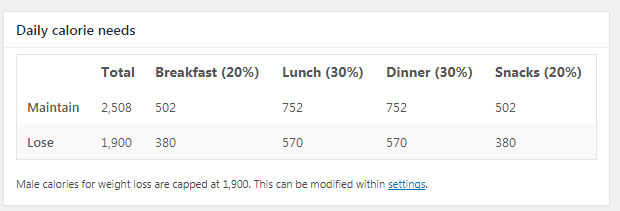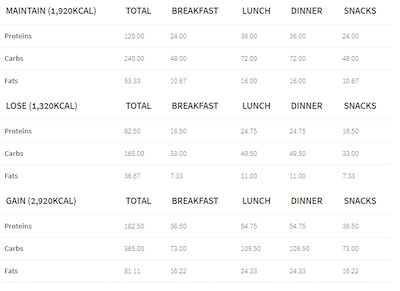 Weight Tracker Documentation
Weight Tracker Documentation
Documentation and tips for setting up Weight Tracker on your WordPress site.
More:
Weight Tracker Plugin / GitHub / YeKen.uk
Calculations
Below summarises how certain default values are calculated within the plugin.
BMR
BMR is short for Basal Metabolic Rate. The Basal Metabolic Rate is the number of calories required to keep the person's body functioning at rest, also known as your metabolism. Weight Loss Tracker calculates BMR using the following formula (taken from www.diabetes.co.uk):
- BMR for Men =
66.47 + (13.7 * weight [kg]) + (5 * size [cm]) − (6.8 * age [years]) - BMR for Women =
655.1 + (9.6 * weight [kg]) + (1.8 * size [cm]) − (4.7 * age [years])
Sources: Be Strong and Diabetes UK.
Harris Benedict Formula
Once a user's BMR has been calculated, the plugin can calculate the user's total calorie intake required to maintain their current weight. This is calculated by multiplying your BMR i.e.
Total Calorie Need to Maintain Weight = BMR x Activity Level
The following are the Activity Levels that can be selected within the plugin and their corresponding multiplying value:
- Little/no exercise: 1.2
- Light exercise: 1.375
- Moderate exercise (3-5 days/wk): 1.55
- Very active (6-7 days/wk): 1.725
- Extra active (very active & physical job): 1.9
Sources Be Strong and Diabetes UK.
CALORIE INTAKE TO LOSE WEIGHT
Based on NICE guidance, which states that to lose weight, the average person should reduce their daily calorie intake by 600kcal the plugin can calculate the recommended daily calorie intake to lose weight i.e.
Daily Calorie Need to Lose weight = Total Calorie Need to Maintain Weight – 600kcal
Depending on your plan, the 600kcal is configurable and can be changed via the plugin's settings page.
Sources: Be Strong, NHS Weight Loss Plan and Day One PDF of the plan.
Based on NHS guidelines this is capped at 1,900kcal for males and 1,400kcal for women. These caps can however be adjusted in the settings page.
Calorie intake to gain weight
If enabled, you can present your users with the recommended number of calories to gain weight.
Daily Calorie Need to Gain weight = Total Calorie Need to Maintain Weight + 500kcal
Depending on your plan, the 500kcal is configurable and can be changed via the plugin's settings page.
Calorie intake broken down into meal times and snacks
With the “Daily Calorie Need to Lose weight” and “Total Calorie Need to Maintain Weight” the plugin can provide recommendations on how to split those calories over the day into meal times / snacks. Based on NHS guidelines this has been split in the following manner:
- Breakfast – 20%
- Lunch – 30%
- Dinner – 30%
- Snacks – 20%
Below is an example of a table generated for a user:
This data is used to power shortcodes such as [wt-calories] and [wt-calories-table].
Macronutrients Calculator
With calories calculated, the plugin's macronutrient calculator can recommend how those calories should be split into Fats, Carbohydrates and Proteins. The 2010 Dietary Guidelines for Americans recommends eating within the following ranges:
- Carbohydrates: 45-65% of calories
- Fat: 20-35% of calories
- Protein: 10-35% of calories
and by default the plugin specifies these to be the following:
- Carbohydrates: 50% of calories
- Fat: 25% of calories
- Protein: 25% of calories
Of course, your idea of what these values should be may be different – therefore the plugin allows you to set these percentages within the settings. From this, number of grams of Carbs, Proteins and Fat that you should have for Maintaining weight or losing weight can be calculated.
The calculator takes these totals for the day and splits them across your daily meals / snacks to suggest how many grams of each you should take. The following percentages are used:
Breakfast
- Breakfast meal = 20% of Daily Protein Grams
- Breakfast meal = 20% of Daily Carbohydrate Grams
- Breakfast meal = 20% of Daily Fat Grams
Lunch
- Lunch meal = 30% of Daily Protein Grams
- Lunch meal = 30% of Daily Carbohydrate Grams
- Lunch meal = 30% of Daily Fat Grams
Dinner
- Dinner meal = 30% of Daily Protein Grams
- Dinner meal = 30% of Daily Carbohydrate Grams
- Dinner meal = 30% of Daily Fat Grams
Snacks
- Snacks = 20% of Daily Protein Grams
- Snacks = 20% of Daily Carbohydrate Grams
- Snacks = 20% of Daily Fat Grams
Below is an example Macronutrient table created for a user:
This data is used to power shortcodes such as [wt-macronutrients] and [wt-macronutrients-table].
Sources: Be Strong, My Fitness Pal Blog and 2010 Dietary Guidelines

